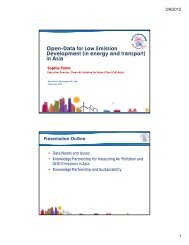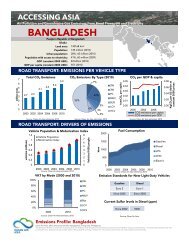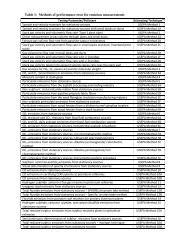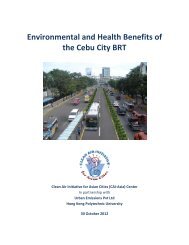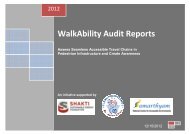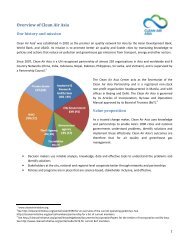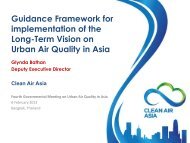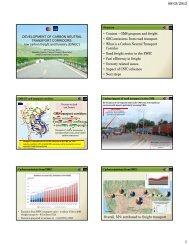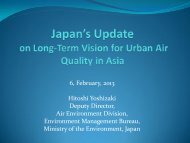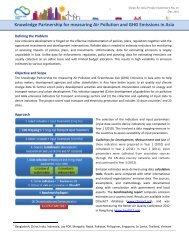International Experience and Best Practices - Clean Air Initiative
International Experience and Best Practices - Clean Air Initiative
International Experience and Best Practices - Clean Air Initiative
You also want an ePaper? Increase the reach of your titles
YUMPU automatically turns print PDFs into web optimized ePapers that Google loves.
4<br />
• How can government ensure a high level of compliance with I/M st<strong>and</strong>ards?<br />
• How can government ensure that following key resources are in sufficient supply?<br />
– Financial resources—for typically a multi-million dollar undertaking<br />
– Institutional capacity—especially in the vehicle service sector<br />
– Political support—critical for the I/M program to survive<br />
ES-2. Eight Essential <strong>Best</strong> <strong>Practices</strong><br />
Four of eight essential best practices concern “institutional design” questions. The other<br />
four relate to the categories of: test procedures <strong>and</strong> emission st<strong>and</strong>ards; enforcement<br />
<strong>and</strong> compliance promotion; <strong>and</strong> managing resources.<br />
Institutional Design<br />
An I/M program should conduct inspections using “test-only” facilities.<br />
Policymakers must choose between a relatively small number of centralized or “test-only”<br />
facilities, <strong>and</strong> a relatively large number of decentralized or “test-<strong>and</strong>-repair” facilities.<br />
Advantages of the former approach include the ability to spread costs over a high volume<br />
of inspections, <strong>and</strong> achieve a low cost per inspection. Additionally, test-only facilities can<br />
afford more costly, sophisticated test equipment by the ability to spread costs. Oversight<br />
of the facilities by government is also relatively easy due to their small number.<br />
Government should set the policy framework <strong>and</strong> provide overall management of<br />
the I/M program while private contractors perform the actual inspections. This<br />
conclusion likely will disturb those who believe every public service should be performed<br />
by a government employee. However, expert opinion is unified on the desirability of<br />
private firms performing this role under the oversight of a governmental body. In general,<br />
this conclusion is driven by the same reasoning that underlies the broader privatization<br />
movement affecting energy, water, transportation, <strong>and</strong> other sectors: many services of a<br />
public nature are best delivered by a private firm accountable to the government rather<br />
than by a state-owned entity that essentially holds a perpetual monopoly in providing the<br />
service. The latter organizational form often suffers from low technical competence <strong>and</strong> a<br />
general inability to punish poor performance or fraud at the individual employee level <strong>and</strong><br />
the organizational level as a whole. A capital-starved public monopoly can be subject to<br />
budgetary pressures from external forces that threaten service quality <strong>and</strong> its ability to<br />
generate revenue, even if it is otherwise capable of providing that service in a financially<br />
viable manner.<br />
Policymakers should exert strong oversight <strong>and</strong> institute a quality assurance<br />
(QA) program for the I/M program. There is no escaping the need to “inspect the<br />
inspectors.” Effective oversight <strong>and</strong> QA is essential to deliver the actual emission<br />
reductions sought <strong>and</strong> help maintain public support for the program. Oversight <strong>and</strong><br />
QA involve a set of highly technical tasks that can be performed by government (if the<br />
capacity exists) or contracting out in part.<br />
Policymakers should implement I/M programs in a phased approach that allows<br />
learning, adaptation, <strong>and</strong> capacity building along the way. Ideally, I/M programs<br />
should begin with the vehicles that emit the most (due to their emission rates, high<br />
mileage, or both). A phase-in of stringency of emission st<strong>and</strong>ards should also be



